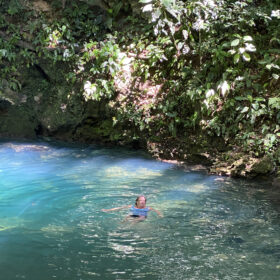
By Pat Foster-Turley
August 18, 2022
These days, I’ve traveled to many places and brought back many souvenirs, but I have stopped collecting objects and am working on rehoming what I already own. So, on our recent vacation to Belize, Bucko and I didn’t go souvenir shopping. I’m done with that, or so I thought.
Instead we focused our time on exploring and meeting people. For the most part we were at a beachside town enjoying its ambience and the friendly locals we soon palled up with. We went on one day-trip to snorkel a reef on an island miles offshore of the mainland. Another day we went on a boat ride and brief jungle walk with an old acquaintance of mine, Jason Williams around his village, Monkey River. Another day we went on an all-day car tour inland to visit a Mayan ruin, with a brief stop on the way back to the Inland Blue Hole, a cenote in the jungle where I enjoyed a wonderful, refreshing dip in clear fresh water. Our vacation was perfect and we already have reservations to return.

About two weeks after we got home, some medical problems erupted in our lives. Mine was the most worrisome. Out of nowhere a robin-egg-sized lump developed on my head and occasional stabs of knife-like pains accompanied it. My primary health doctor was befuddled about what it was, and suggested a biopsy which I received shortly thereafter at Beaches Dermatology since they couldn’t identify it either and wanted to rule out cancer. Oh no. Possible cancer???? Bucko and I anxiously awaited the biopsy results which would take a week or more.
Somewhere during this process Bucko became concerned about the wound he had on his arm that developed around the same time. All the antibiotic creams he used had no effect—it just kept weeping yellow fluid and getting larger. And, wait, is that something moving in the middle of the sore? That’s when the “eureka” moment hit Bucko. It was a botfly larva—a maggot—living under his skin!

Bucko and I both went together to Beaches Dermatology. They had never encountered such a thing! Nathaniel Swartz, our PA, after consulting with the doctors, prescribed Ivermectin, that animal deworming medicine, for Bucko. And then he removed the five stitches on my head from the biopsy and my own botfly, long dead presumably from the biopsy, popped out of my head. Nate was overjoyed. I said to Nate, “This must be the most exciting thing to happen to you all day.” And he said, “No it was the most exciting thing all year!!!” And the best was yet to come. A few days after Bucko’s Ivermectin dose, he was able to work his own now-dead botfly out of his skin, fully intact, and now residing in a vial of alcohol. I’ve named it Boris Botfly, and soon I will deliver it to the medical entomology department at the University of Florida—they are thrilled to have it.
You might be wondering about the results of the biopsy. It eventually came back with a diagnosis of “hypersensitivity dermatitis” which could be attributed to a number of things including “responses to arthropod assaults.” Right on!
It turns out that there are a number of reported cases of human botflies from the jungles of Belize and most Central and South American tropical countries. But our own cases are a mystery to those we have contacted back in Belize. Jason, the Monkey River resident, says no one there has reported a botfly in years, and he himself had one once when he was 15 years old, twenty or more years ago. And the tour guides that take people to the Inland Blue Hole haven’t known of recent cases either. How Bucko and I both got botflies in our maybe three hours total in a jungle environment is a mystery to them too.
I now know quite a bit about human botflies. A female botfly (about the size of a small bee) lays eggs on a mosquito and when the mosquito bites a person, the eggs enter the wound. Here the egg grows into a larva, in a number of stages, and gets bigger and bigger until it drops out to finish its life cycle in the ground. A botfly maggot has a number of rows of backwards directed spines that keep the host (us) from pulling it out when it is alive. Luckily ours were extracted before they reached the largest size—it was painful enough when still small.


So, we did bring back souvenirs from Belize, unexpected ones. But our medical adventure made lots of people happy with our discovery. And Boris now will “live on” forever training new scientists and doctors at the University of Florida. It sure beats a wood carving souvenir any day!
Pat Foster-Turley, PhD is a zoologist on Amelia Island. She welcomes your nature questions and observations. [email protected]

Oh wow. Very interesting and so glad they are out! And you both are okay. Botfly reading is now on my further reading list.Maybe no more Blue Holes?
Great story and that both of you turned out ok. Another adventure and Science benefits! Botflies, who knew?